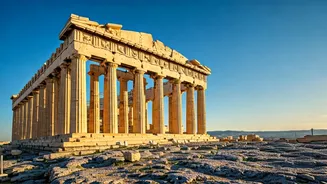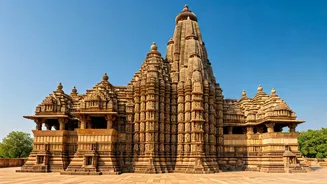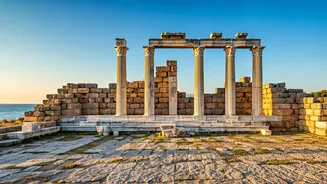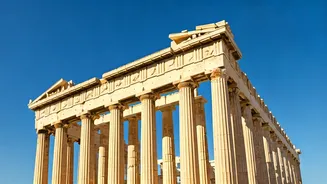Acropolis of Athens
The Acropolis, perched high above Athens, is arguably the most iconic ancient Greek site. It stands as a testament to the classical period, showcasing
the architectural and artistic prowess of the ancient Athenians. The Parthenon, the most prominent structure, was dedicated to the goddess Athena, and exemplifies Doric order architecture. Beyond the Parthenon, the Propylaea, Erechtheion, and Temple of Athena Nike are also noteworthy. The Acropolis served not only as a religious center, but also as a symbol of Athenian power and cultural achievements. Exploring its ruins allows visitors to appreciate the scale and sophistication of ancient Greek civilization, as well as its enduring impact on art and architecture. The Acropolis is a UNESCO World Heritage site and attracts millions of visitors annually, all keen to marvel at its timeless beauty.
Delphi: The Oracle
Delphi, nestled on the slopes of Mount Parnassus, was the spiritual center of ancient Greece. Its significance lies in the Temple of Apollo, where the Oracle delivered prophecies considered crucial for political and personal decisions. The site also includes the Treasury of the Athenians, the theater, and a stadium. Visitors can imagine the crowds that once flocked to Delphi, seeking guidance and interpreting the Oracle's pronouncements. The Panhellenic Sanctuary, home to various treasuries and votive offerings from different Greek city-states, shows the importance of Delphi. The breathtaking landscape provides an added dimension to the experience. For those seeking historical context, Delphi offers a look into the religious beliefs and practices that shaped ancient Greek society, highlighting the profound influence of oracles on the lives of both individuals and the state. Today, the ruins continue to inspire wonder, reminding visitors of the enduring power of myth and prophecy.
Olympia: Birthplace
Olympia, located in the Peloponnese, is renowned as the birthplace of the Olympic Games. This sacred site was dedicated to Zeus, where athletes from across the Greek world competed in athletic and religious festivals. The remains of the ancient stadium, the Temple of Zeus (one of the largest temples in ancient Greece), and the Temple of Hera are central to Olympia's significance. Visitors can imagine the excitement of the games, the competitive spirit, and the athletic achievements of the ancient Greeks. Statues, altars, and votive offerings reveal details of the religious practices and the values emphasized during the Games. The Olympic Games, held every four years, were a symbol of peace and unity, bringing together various city-states in a spirit of friendly competition. The influence of the Olympics can be seen in its impact on sports, fair play and global unity. Exploring Olympia allows visitors to connect with the origins of sports and the enduring legacy of the Olympic ideals.
Knossos: Minoan Palace
Knossos, located on the island of Crete, is the most famous site of the Minoan civilization. This complex palace, with its elaborate architecture and colorful frescoes, offers insight into the advanced culture that thrived in the Bronze Age. The Minoans, known for their sophisticated lifestyle and unique art, built a multi-storied palace complex, with living quarters, workshops, and religious spaces. The intricate frescoes depict scenes of daily life, ceremonies, and the natural world, giving clues to the Minoan society's values and beliefs. The archaeological site also includes storage magazines, a theater area, and various courtyards. Exploring Knossos, visitors can learn about the Minoan civilization, which flourished for over a thousand years. The palace’s layout, featuring winding corridors and numerous rooms, is thought to have inspired the myth of the Minotaur and the labyrinth. The ruins of Knossos provide a fascinating glimpse into the lives of the people who shaped Crete's early history.
Ephesus: Roman City
Ephesus, in modern-day Turkey, was a major city of the Roman Empire, famed for its grandeur and prosperity. Although located in Turkey, Ephesus played a significant role in Greek history. The city's extensive ruins include the Library of Celsus, the Temple of Artemis (one of the Seven Wonders of the Ancient World), a grand theater, and well-preserved streets. The Library of Celsus showcases the architectural sophistication and intellectual pursuits of the Romans. The theater, with its vast seating capacity, hosted both theatrical performances and gladiatorial contests. Ephesus was an important center for commerce, religion, and culture. The city flourished due to its strategic location, which made it a hub for trade and cross-cultural exchange. Touring Ephesus allows visitors to experience the vibrant life of a Roman city, with its infrastructure, social life, and its influence on later civilizations. It also provides insight into the Roman Empire's expansion and its legacy.
Meteora: Monasteries
Meteora, located in Thessaly, is a unique site where ancient monasteries sit atop towering sandstone pillars. This location combines natural beauty with human achievement. The monasteries, built in the Byzantine era, provided remote sanctuaries for monks seeking solitude and spiritual devotion. The location of the monasteries offered strategic defense against invaders. The architecture showcases the resilience and resourcefulness of the monks who constructed these structures in such an inaccessible setting. The Meteora monasteries offer visitors both historical and aesthetic appeal. They are not only a symbol of religious devotion but also a testament to human determination. These monasteries provide an insight into Byzantine religious life, art, and the history of monasticism, all set amidst a stunning natural landscape that captivates every visitor.
Mycenae: Bronze Age
Mycenae, located in the Peloponnese, was a leading city of the Mycenaean civilization, flourishing during the Bronze Age. Known for its imposing Cyclopean walls, the Lion Gate, and the Treasury of Atreus, Mycenae provides a glimpse into the military might and wealth of the Mycenaean rulers. The Lion Gate is a symbol of Mycenaean power and architectural skill, serving as the main entrance to the citadel. The Treasury of Atreus, a large tomb, displays advanced engineering. The Mycenaeans were a warrior culture, known for their advanced metalworking and maritime trade. The ruins highlight their organization and military capabilities. Exploring Mycenae allows visitors to appreciate the achievements of a civilization that preceded classical Greece, helping to fill in the missing pieces of European history. It shows the roots of Greek culture and its role in shaping Western civilization.
Delos: Sacred Island
Delos, a small island in the Cyclades, was a sacred site in ancient Greece, and also served as a significant commercial hub. Dedicated to the gods Apollo and Artemis, Delos attracted pilgrims from across the Greek world. The island’s ruins include temples, sanctuaries, and marketplaces, showcasing its religious and commercial importance. The Terrace of the Lions, dedicated to Apollo, is a notable feature. The Sanctuary of Apollo, a complex of temples, was a key religious center. The island’s role as a trading center promoted interactions between different cultures, and was central to the Greek world. Delos provides an insight into the religious practices, social activities, and commercial operations of the ancient Greeks. Exploring Delos offers an unique glimpse into the multifaceted nature of ancient Greek civilization, displaying its religious significance and its commercial activity.














